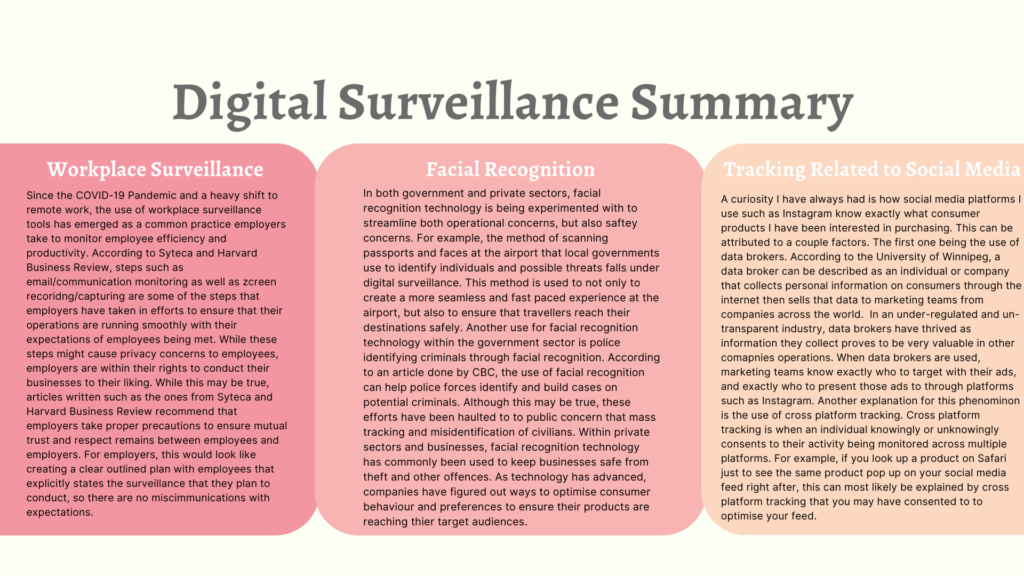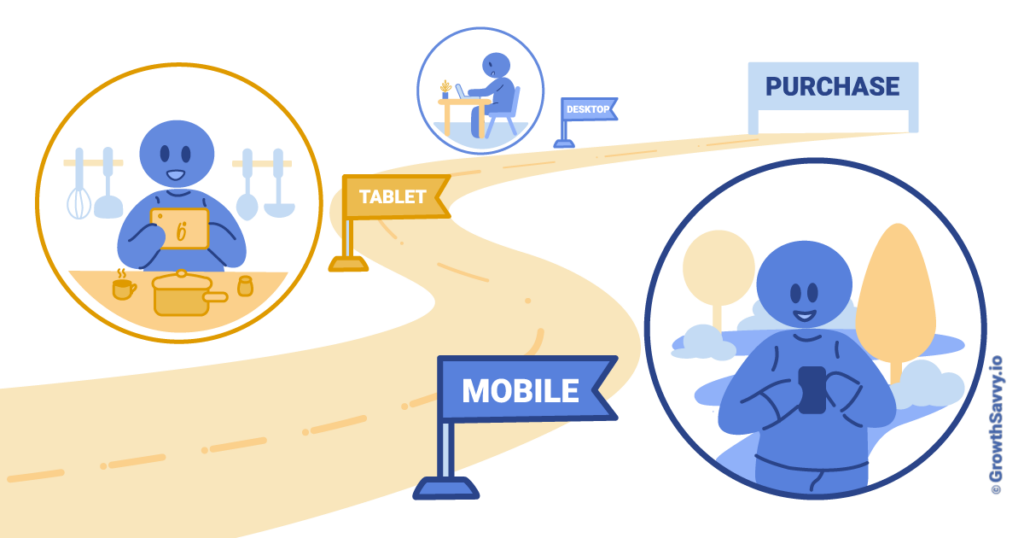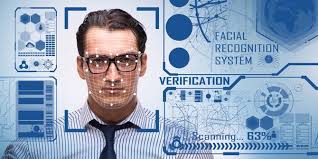
Over the duration of being in this class, I have had an emerging interest in studying digital surveillance and how it impacts different areas. Some of these areas such as facial recognition technology use in places like airports are apparent and clear, as many individuals have experienced this type of digital surveillance. Other areas of digital surveillance such as cross platform tracking are topics that individuals might be more curious about, as the process in which this occurs is a lot less apparent than other areas of digital surveillance. With that being said, the main goal of my summative project was to determine how digital surveillance impacts personal security and safety. Additionally, I have taken an interest in researching how different areas of digital surveillance have attempted to strike a balance to ensure that digital surveillance is being used for the right reasons. Undoubtedly, the use of digital surveillance in general is a groundbreaking discovery that has the potential to extremely positively impact various areas. Although this is true, we as individuals and bodies of power have the responsibility to ensure the use of this digital surveillance is being done ethically.
A study done by Technology Innovation Management (TIM) Review surveyed 1486 Canadians on topics related to digital surveillance, in reference to how digital surveillance influences individual opinions on governing bodies. After the survey was done, researchers at TIM concluded that while digital surveillance concerns negatively impacted the acceptance of frequent digital surveillance tools being used in areas of interest, these digital surveillance initiatives did not cause the majority of individuals to lose trust in the government. This could potentially be attributed to a common understanding that the government is trying to act in the best interest of its citizens, even though this may mean that individuals of no interest are also being subject to digital surveillance measures. The study done also makes some key points about how transparency and clarity surrounding digital surveillance is one of the most important factors surrounding this issue. If individuals truly understand what this technology is being used for, they will more likely accept it and be able to appreciate the intended purpose of it. Lastly, a point was made about digital surveillance that states that if you do not agree to be surveilled, you need to take measures to combat it such as reading fine print and not consenting to personal things such as data collection.
In terms of digital surveillance in relation to workplace surveillance, there are many resources and experts to consult to ensure that digital surveillance in the workplace is being conducted ethically and for the right reasons. The biggest point to make about workplace surveillance is that there should be clear and open channels of communication between employees and employers. This means that to ethically carry out workplace surveillance, employers should be able to communicate what exactly is being monitored and why it is being monitored. When this communication is able to happen, it allows for employees to avoid conducting business at work that they would not want to be monitored, as well as creating a common understanding as to why the surveillance benefits both parties. When there steps and precautions are carried out, I do believe that the use of digital surveillance in the workplace is ethical. As companies are allowed to digitally surveil, I personally would have no issues with this implimentation as long as I am fully aware of what is being surveilled and why is is happening. On the flip side, if a company were to digitally surveil without saying anything to employees, I would be lead to believe that this type of surveillance would be unethical.
Secondly, facial recognition technology within digital surveillance follows a somewhat similar formula to digital surveillance within the workplace, with a key emphasis on transparency. In relation to facial recognition technology being used at airports, through sources I have researched I am lead to believe that the use of this technology is completely ethical. I say this because I have experienced first hand as a frequent traveller that when airports and governments started making a further shift towards facial recognition, I was able to have more seamless experiences in different airports around the world. While I was subject to facial recognition technology, I as a law abiding citizen had nothing to worry about. Within this scope, I understand that while all individuals may be subject to facial recognition technology being applied to them, the technology is being used to help create a streamlined experience at the airport while also being used to identify individuals who may be of danger, so in my opinion this technology is being used only for the benefit of everyone involved and is in fact completely ethical. I have a similar opinion surrounding the use of facial recognition use by police forces. I understand that I may be being unintentionally surveilled, but I have a bigger concern for individuals having an easier time committing crimes, so I believe that the use of facial recognition within police operations is ethical and being used to benefit the vast majority of law abiding citizens. The area I start to have some wonders about facial recognition is in the private sector. As companies have figured out ways to use facial recognition technology to analyze consumer behaviour, there is potential for any individual to be watched at all times while carrying out daily tasks such as shopping. While I appreciate efforts to be presented with what I want to see, there is little transparency surrounding this, making me believe that it is potentially unethical.
Lastly, the area where I believe to be the most unethical within the digital surveillance areas I have studied is tracking related to social media. To begin, the use of data brokers to collect personal information is one I believe to be quite unethical. While individuals consent to this data collection, may times it is not clear and transparent to what they are consenting to, with sometimes this consent being mandatory to access a website or app. Throughout this final project, a common theme has been transparency. I believe that transparency is directly related to the ethics surrounding this technology, as if people know about what they are consenting to then they will be able to have a choice, making it ethical. When data is collected by data brokers through hidden initiatives and unclear motives, I believe it is unethical because the majority of individuals most likely don’t know that it’s happening, compromising both safety and security. While I believe that cross platform tracking is more ethical than data brokerage, I still don’t believe that it is completely ethical due to the fact that lots of individuals are also unaware that it is happening. While I personally don’t mind that my feed gets optimized so I see exactly what I want to see, in terms of transparency and the grand scope of the project, I believe that the use of any digital surveillance technology without clear and outlined goals and communication is where things start to become unethical.
After reading my final project I invite you to share your thoughts with me! What is your opinion on digital surveillance? What is your main criteria (maybe transparency) to determine ion digital surveillance initiatives are ethical? Let me know!
Sources/Articles Consulted
https://piwik.pro/blog/cross-platform-analytics/
https://www.cbc.ca/news/politics/facial-recognition-ai-police-canada-1.7251065
https://hbr.org/2020/12/if-youre-tracking-employee-behavior-be-transparent-about-it
https://www.theatlantic.com/business/archive/2018/10/employee-surveillance/568159/
https://timreview.ca/article/1427






